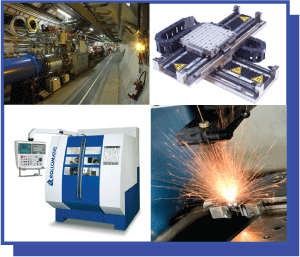 The robust control design methods developed in the Linear System Group have been applied on many industrial and academic applications as well as international benchmarks. Some of the control application are listed below:
The robust control design methods developed in the Linear System Group have been applied on many industrial and academic applications as well as international benchmarks. Some of the control application are listed below:
Voltage and Current Control in Electronic Converters
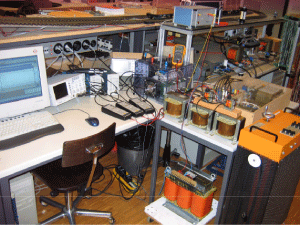 A multivariable digital control design methodology for the voltage regulation in electronic converters is developed. The controller design methodology, based on a family of spectral Multi-Input Multi-Output (MIMO) models of the system, develops a convex optimization-based problem to carry out the system open-loop shaping. The control design procedure includes: (i) the determination of a family of nonparametric models of the system at various operating points, (ii) the determination of the class of the controller, and (iii) the system open-loop shaping by convex minimization of the summation of the norm of the errors between the system open-loop transfer functions and a desired open-loop transfer function. The proposed controllers guarantee the robust stability and fast dynamic response performance of the system in spite of load parametric uncertainties and also the presence of nonlinear load.
A multivariable digital control design methodology for the voltage regulation in electronic converters is developed. The controller design methodology, based on a family of spectral Multi-Input Multi-Output (MIMO) models of the system, develops a convex optimization-based problem to carry out the system open-loop shaping. The control design procedure includes: (i) the determination of a family of nonparametric models of the system at various operating points, (ii) the determination of the class of the controller, and (iii) the system open-loop shaping by convex minimization of the summation of the norm of the errors between the system open-loop transfer functions and a desired open-loop transfer function. The proposed controllers guarantee the robust stability and fast dynamic response performance of the system in spite of load parametric uncertainties and also the presence of nonlinear load.
Publications:
Nicoletti, Achille, Michele Martino, and Alireza Karimi. “A Data-Driven Approach to Power Converter Control via Convex Optimization.” Proceddings of the 1st IEEE Conference on Control Technology and Applications. No. EPFL-CONF-228599. 2017.
Multivariable Control of Single-Inductor Dual-Output Buck Converters, in IEEE Transactions on Power Electronics, vol. 29, num. 4, p. 2061-2070, 2014.
Tool Wear Compensation in Milling Electro-Discharge Machining
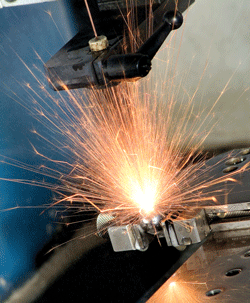 Milling Electro-Discharge Machining (EDM) represents a novel technology with the potential to both replace sinking EDM in some applications (eliminating the need for electrode shaping) and to open new areas (e.g. micro-EDM milling). The main challenge is represented by the small size of the electrode tool: its geometry change due to the electrode wear during a single operation can no longer be neglected, neither it can be compensated for by constant renewal of the electrode such as in wire EDM. Moreover, the natural frequencies of the system are in the bandwidth of the sparking excitation, resulting in vibrations that reduce the machining tolerances. The project main goal is to use the electric signals measured by the machine sparking control unit (however necessary for servo feed and sparking control) to reconstruct the electrode tool vibration spectrum, which is correlated with the electrode-workpiece instantaneous gap and thus with the stochastically varying sparking time delay. DSP techniques for nonuniformly sampled, nonstationary signals (i.e. time-frequency distributions) are required. Through nonparametric identification of the system dynamics, the spectrum information allows estimation of the instantaneous tool length. Therefore online wear compensation for the length decrease by additional z-feed becomes possible, without any need to stop machining or install additional measurement hardware. In addition, the sparking characteristics can be tailored in order to minimize the vibration response of the electrode.
Milling Electro-Discharge Machining (EDM) represents a novel technology with the potential to both replace sinking EDM in some applications (eliminating the need for electrode shaping) and to open new areas (e.g. micro-EDM milling). The main challenge is represented by the small size of the electrode tool: its geometry change due to the electrode wear during a single operation can no longer be neglected, neither it can be compensated for by constant renewal of the electrode such as in wire EDM. Moreover, the natural frequencies of the system are in the bandwidth of the sparking excitation, resulting in vibrations that reduce the machining tolerances. The project main goal is to use the electric signals measured by the machine sparking control unit (however necessary for servo feed and sparking control) to reconstruct the electrode tool vibration spectrum, which is correlated with the electrode-workpiece instantaneous gap and thus with the stochastically varying sparking time delay. DSP techniques for nonuniformly sampled, nonstationary signals (i.e. time-frequency distributions) are required. Through nonparametric identification of the system dynamics, the spectrum information allows estimation of the instantaneous tool length. Therefore online wear compensation for the length decrease by additional z-feed becomes possible, without any need to stop machining or install additional measurement hardware. In addition, the sparking characteristics can be tailored in order to minimize the vibration response of the electrode.
Modeling and Robust Control of Direct-Drive Motors
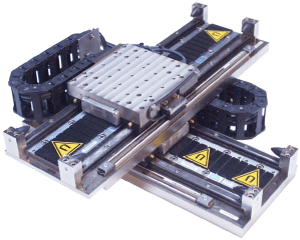 The high precision position control of linear direct-drive motors requires the modeling of the system including the friction nonlinearity, reluctant and cogging forces together with the model parameter uncertainties. Besides, the model parameters may change in different operation points. In order to obtain a stable and high performance control system several robust control methods are considered:
The high precision position control of linear direct-drive motors requires the modeling of the system including the friction nonlinearity, reluctant and cogging forces together with the model parameter uncertainties. Besides, the model parameters may change in different operation points. In order to obtain a stable and high performance control system several robust control methods are considered:
Control of Resonant Systems (International Benchmarks)
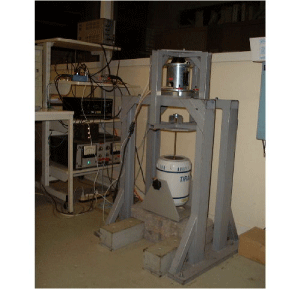
Flexible systems with very low damping factor are in general very difficult to control in the presence of large load variation. However, a high performance controller is normally needed for this type of systems, particularly in aerospace applications.
Design of low-order controllers for an active suspension system is the subject of an international benchmark on active suspension control. The new methods are applied to this active suspension benchmark and another international benchmark on a flexible transmission system.